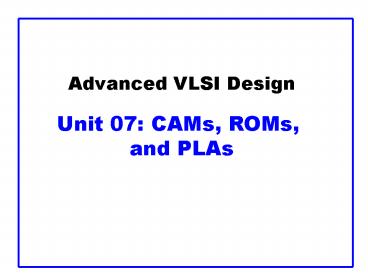Advanced VLSI Design Unit 07: CAMs, ROMs, - PowerPoint PPT Presentation
1 / 30
Title:
Advanced VLSI Design Unit 07: CAMs, ROMs,
Description:
Advanced VLSI Design Unit 07: CAMs, ROMs, and PLAs Outline Content-Addressable Memories Read-Only Memories Programmable Logic Arrays CAMs Extension of ordinary memory ... – PowerPoint PPT presentation
Number of Views:239
Avg rating:3.0/5.0
Title: Advanced VLSI Design Unit 07: CAMs, ROMs,
1
Advanced VLSI DesignUnit 07 CAMs, ROMs, and
PLAs
2
Outline
- Content-Addressable Memories
- Read-Only Memories
- Programmable Logic Arrays
3
CAMs
- Extension of ordinary memory (e.g. SRAM)
- Read and write memory as usual
- Also match to see which words contain a key
4
10T CAM Cell
- Add four match transistors to 6T SRAM
- 56 x 43 l unit cell
5
CAM Cell Operation
- Read and write like ordinary SRAM
- For matching
- Leave wordline low
- Precharge matchlines
- Place key on bitlines
- Matchlines evaluate
- Miss line
- Pseudo-nMOS NOR of match lines
- Goes high if no words match
6
Read-Only Memories
- Read-Only Memories are nonvolatile
- Retain their contents when power is removed
- Mask-programmed ROMs use one transistor per bit
- Presence or absence determines 1 or 0
7
ROM Example
- 4-word x 6-bit ROM
- Represented with dot diagram
- Dots indicate 1s in ROM
Word 0 010101 Word 1 011001 Word 2 100101 Word
3 101010
Looks like 6 4-input pseudo-nMOS NORs
8
ROM Array Layout
- Unit cell is 12 x 8 l (about 1/10 size of SRAM)
9
Row Decoders
- ROM row decoders must pitch-match with ROM
- Only a single track per word!
10
Complete ROM Layout
11
PROMs and EPROMs
- Programmable ROMs
- Build array with transistors at every site
- Burn out fuses to disable unwanted transistors
- Electrically Programmable ROMs
- Use floating gate to turn off unwanted
transistors - EPROM, EEPROM, Flash
12
Building Logic with ROMs
- Use ROM as lookup table containing truth table
- n inputs, k outputs requires __ words x __ bits
- Changing function is easy reprogram ROM
- Finite State Machine
- n inputs, k outputs, s bits of state
- Build with ________ bit ROM and ____ bit reg
13
Building Logic with ROMs
- Use ROM as lookup table containing truth table
- n inputs, k outputs requires 2n words x k bits
- Changing function is easy reprogram ROM
- Finite State Machine
- n inputs, k outputs, s bits of state
- Build with 2ns x (ks) bit ROM and (ks) bit reg
14
Example RoboAnt
- Lets build an Ant
- Sensors Antennae
- (L,R) 1 when in contact
- Actuators Legs
- Forward step F
- Ten degree turns TL, TR
- Goal make our ant smart enough to
- get out of a maze
- Strategy keep right antenna on wall
- (RoboAnt adapted from MIT 6.004 2002
OpenCourseWare by Ward and Terman)
L
R
15
Lost in space
- Action go forward until we hit something
- Initial state
16
Bonk!!!
- Action turn left (rotate counterclockwise)
- Until we dont touch anymore
17
A little to the right
- Action step forward and turn right a little
- Looking for wall
18
Then a little to the right
- Action step and turn left a little, until not
touching
19
Whoops a corner!
- Action step and turn right until hitting next
wall
20
Simplification
- Merge equivalent states where possible
21
State Transition Table
S10 L R S10 TR TL F
00 0 0 00 0 0 1
00 1 X 01 0 0 1
00 0 1 01 0 0 1
01 1 X 01 0 1 0
01 0 1 01 0 1 0
01 0 0 10 0 1 0
10 X 0 10 1 0 1
10 X 1 11 1 0 1
11 1 X 01 0 1 1
11 0 0 10 0 1 1
11 0 1 11 0 1 1
Lost
RCCW
Wall1
Wall2
22
ROM Implementation
- 16-word x 5 bit ROM
23
ROM Implementation
- 16-word x 5 bit ROM
24
PLAs
- A Programmable Logic Array performs any function
in sum-of-products form. - Literals inputs complements
- Products / Minterms AND of literals
- Outputs OR of Minterms
- Example Full Adder
25
NOR-NOR PLAs
- ANDs and ORs are not very efficient in CMOS
- Dynamic or Pseudo-nMOS NORs are very efficient
- Use DeMorgans Law to convert to all NORs
26
PLA Schematic Layout
27
PLAs vs. ROMs
- The OR plane of the PLA is like the ROM array
- The AND plane of the PLA is like the ROM decoder
- PLAs are more flexible than ROMs
- No need to have 2n rows for n inputs
- Only generate the minterms that are needed
- Take advantage of logic simplification
28
Example RoboAnt PLA
- Convert state transition table to logic equations
S10 L R S10 TR TL F
00 0 0 00 0 0 1
00 1 X 01 0 0 1
00 0 1 01 0 0 1
01 1 X 01 0 1 0
01 0 1 01 0 1 0
01 0 0 10 0 1 0
10 X 0 10 1 0 1
10 X 1 11 1 0 1
11 1 X 01 0 1 1
11 0 0 10 0 1 1
11 0 1 11 0 1 1
29
RoboAnt Dot Diagram
30
RoboAnt Dot Diagram

